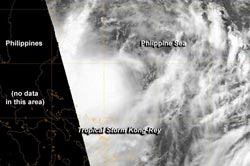NASA Catches Tropical Storm Kong-Rey Form in Northwestern Pacific

On Aug. 26 at 0432 UTC/12:32 a.m. EDT, NASA's Aqua satellite passed over the eastern half of newborn Tropical Storm Kong-Rey. Image Credit: NRL/NASA<br>
Tropical Storm Kong-Rey formed from low pressure System 91W. It is located east of the northeast Philippines and bringing the region gusty winds, rains and rough seas today, Aug 26.
Aqua passed over Tropical Storm Kong-Rey on Aug. 26 at 0432 UTC/12:32 a.m. EDT as it was strengthening from a tropical depression into a tropical storm. The Moderate Resolution Imaging Spectroradiometer or MODIS instrument aboard Aqua captured a visible image of Kong-Rey that showed a rounded circulation.
Although MODIS did not capture any data over the Philippines, Kong-Rey is far enough east of the island nation that most of the storm was in its sights.
A tropical cyclone is made up of hundreds of thunderstorms and the MODIS imagery showed strong thunderstorms around the center of circulation that were casting shadows on the lower surrounding thunderstorms.
Satellite imagery also revealed banding of thunderstorms was beginning to occur.
On Aug. 25 at 1500 UTC/11 a.m. EDT Kong-Rey's maximum sustained winds were near 35 knots/40 mph/55 kph. The storm was centered near 17.7 north and 123.9 east, about 241 nautical miles northeastward of Manila, Philippines, has tracked northwestward at 12 knots/13.8 mph/22.2 kph. Tropical Storm Kong-Rey was bringing rainfall to eastern Luzon.
The forecast along the eastern seaboard of Central and Southern Luzon for Aug. 26 calls for cloudy skies with scattered to widespread rain showers and thunderstorms. According to PAGASA, the Phillippine Atmospheric and Astronomical Services Administration, winds in that area area expected to be sustained between 32 and 39 mph/52 and 63 kph/28 to 34 knots/ and seas are expected to be very rough as Kong-Rey continues moving past the northern Philippines.
Kong-Rey is forecast to move northwest and move past Luzon and pass to the east of Taiwan on its northern journey.
Text: Rob Gutro
NASA's Goddard Space Flight Center
Media Contact
All latest news from the category: Earth Sciences
Earth Sciences (also referred to as Geosciences), which deals with basic issues surrounding our planet, plays a vital role in the area of energy and raw materials supply.
Earth Sciences comprises subjects such as geology, geography, geological informatics, paleontology, mineralogy, petrography, crystallography, geophysics, geodesy, glaciology, cartography, photogrammetry, meteorology and seismology, early-warning systems, earthquake research and polar research.
Newest articles

Superradiant atoms could push the boundaries of how precisely time can be measured
Superradiant atoms can help us measure time more precisely than ever. In a new study, researchers from the University of Copenhagen present a new method for measuring the time interval,…

Ion thermoelectric conversion devices for near room temperature
The electrode sheet of the thermoelectric device consists of ionic hydrogel, which is sandwiched between the electrodes to form, and the Prussian blue on the electrode undergoes a redox reaction…

Zap Energy achieves 37-million-degree temperatures in a compact device
New publication reports record electron temperatures for a small-scale, sheared-flow-stabilized Z-pinch fusion device. In the nine decades since humans first produced fusion reactions, only a few fusion technologies have demonstrated…





















